Showing Spotlights 89 - 96 of 203 in category All (newest first):
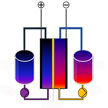 Flow batteries are regarded as one of the most promising energy storage technologies for stationary large-scale storage because the power capability and the energy storage capability of these storage systems can be sized independently, which benefits load balancing, peak shaving, power conversion and stand-alone power system. As an emerging rechargeable battery technology, lithium redox flow batteries (Li-RFB) represent an important advance which is distinct from conventional solid-state rechargeable batteries. Researchers have now demonstrated an all-metallocene-based non-aqueous redox flow battery with stable cycling performance and comparable energy density with current related energy storage technologies.
Flow batteries are regarded as one of the most promising energy storage technologies for stationary large-scale storage because the power capability and the energy storage capability of these storage systems can be sized independently, which benefits load balancing, peak shaving, power conversion and stand-alone power system. As an emerging rechargeable battery technology, lithium redox flow batteries (Li-RFB) represent an important advance which is distinct from conventional solid-state rechargeable batteries. Researchers have now demonstrated an all-metallocene-based non-aqueous redox flow battery with stable cycling performance and comparable energy density with current related energy storage technologies.
Feb 27th, 2017
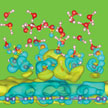 Researchers have shown that evaporation from the surface of a variety of nanostructured carbon materials can be used to generate electricity: the evaporation driven water flow in nanoporous carbon film converts ambient thermal energy into electricity via the water molecules' interaction with the carbon material. The team fabricated their device from a sheet of carbon black and two electrodes made from multi-walled carbon nanotubes. When inserted into deionized water, an open-circuit voltage between the two electrodes is generated.
Researchers have shown that evaporation from the surface of a variety of nanostructured carbon materials can be used to generate electricity: the evaporation driven water flow in nanoporous carbon film converts ambient thermal energy into electricity via the water molecules' interaction with the carbon material. The team fabricated their device from a sheet of carbon black and two electrodes made from multi-walled carbon nanotubes. When inserted into deionized water, an open-circuit voltage between the two electrodes is generated.
Feb 21st, 2017
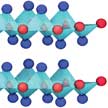 Researchers have demonstrated that nanoengineered SnO anodes suppress volume change and prolong sodium ion battery cycle life. Sodium ion batteries are promising alternative to lithium ion batteries, particularly for home based and grid level storage solutions. Tin monoxide has been demonstrated to have excellent physical and chemical properties and has a large theoretical capacity as battery anode, for instance for sodium ion batteries. Unfortunately, though, it also exhibits large volume change during the sodiation and lithiation process, which makes it unsuitable as a high-performing anode material.
Researchers have demonstrated that nanoengineered SnO anodes suppress volume change and prolong sodium ion battery cycle life. Sodium ion batteries are promising alternative to lithium ion batteries, particularly for home based and grid level storage solutions. Tin monoxide has been demonstrated to have excellent physical and chemical properties and has a large theoretical capacity as battery anode, for instance for sodium ion batteries. Unfortunately, though, it also exhibits large volume change during the sodiation and lithiation process, which makes it unsuitable as a high-performing anode material.
Feb 9th, 2017
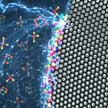 Researchers have successfully demonstrated a facile but effective regulation strategy to render uniform Li deposits by incorporating fluoroethylene carbonate additives. This addresses an issue where safety and uniform deposits of Li ion are critical issues for promoting the practical application of metallic Li as anode for post Li-ion batteries, including rechargeable Li-S, Li-air batteries, and even Li metal batteries which utilize intercalation compounds as cathodes.
Researchers have successfully demonstrated a facile but effective regulation strategy to render uniform Li deposits by incorporating fluoroethylene carbonate additives. This addresses an issue where safety and uniform deposits of Li ion are critical issues for promoting the practical application of metallic Li as anode for post Li-ion batteries, including rechargeable Li-S, Li-air batteries, and even Li metal batteries which utilize intercalation compounds as cathodes.
Jan 30th, 2017
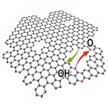 The oxygen reduction reaction (ORR) is the core process - but also the bottleneck - for the cathode reaction of energy-conversion devices like certain types of fuel cells and metal-air batteries. Nanocarbon materials are very promising alternatives for the noble metal catalysts, especially platinum, that have been used to boost this reaction. New work comprehensively reviews and correlates activity origins of nanocarbon-based ORR electro�catalysts, considering the dopants, edges, and defects. Specific doping at defective edges is expected to render practical applications for metal-free nanocarbon electrocatalysts.
The oxygen reduction reaction (ORR) is the core process - but also the bottleneck - for the cathode reaction of energy-conversion devices like certain types of fuel cells and metal-air batteries. Nanocarbon materials are very promising alternatives for the noble metal catalysts, especially platinum, that have been used to boost this reaction. New work comprehensively reviews and correlates activity origins of nanocarbon-based ORR electro�catalysts, considering the dopants, edges, and defects. Specific doping at defective edges is expected to render practical applications for metal-free nanocarbon electrocatalysts.
Jan 12th, 2017
 Methanol fuel cells are widely considered as a potential source of future energy due to the usage of methanol as a liquid fuel; simplicity in operation; higher energy density of methanol fuel; high power density obtained etc. However their commercialization is greatly hindered by methanol crossover taking place in the membrane area of fuel cells, leading to short circuits and greatly affecting overall performance. By using two-dimensional (2D) materials - graphene and hexagonal boron nitride (hBn) - in methanol fuel cell systems, researchers now have overcome this bottleneck.
Methanol fuel cells are widely considered as a potential source of future energy due to the usage of methanol as a liquid fuel; simplicity in operation; higher energy density of methanol fuel; high power density obtained etc. However their commercialization is greatly hindered by methanol crossover taking place in the membrane area of fuel cells, leading to short circuits and greatly affecting overall performance. By using two-dimensional (2D) materials - graphene and hexagonal boron nitride (hBn) - in methanol fuel cell systems, researchers now have overcome this bottleneck.
Dec 7th, 2016
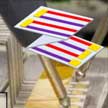 Flexible thermoelectric generators that are capable of producing electricity out of a temperature difference could have many applications in consumer and medical electronics. However, conventional thermoelectric materials are rigid and brittle and don't lend themselves to be used with flexible devices. Researchers have now demonstrated a flexible paper-based devices can be easily stacked or efficiently folded and cut through origami and kirigami techniques so that it is possible to achieve higher power densities. This allows for enough electricity to be generated to supply low-power systems, especially in applications where flexibility is advantageous, such as robotics, cybernetics, wearable devices or bio-integrated systems.
Flexible thermoelectric generators that are capable of producing electricity out of a temperature difference could have many applications in consumer and medical electronics. However, conventional thermoelectric materials are rigid and brittle and don't lend themselves to be used with flexible devices. Researchers have now demonstrated a flexible paper-based devices can be easily stacked or efficiently folded and cut through origami and kirigami techniques so that it is possible to achieve higher power densities. This allows for enough electricity to be generated to supply low-power systems, especially in applications where flexibility is advantageous, such as robotics, cybernetics, wearable devices or bio-integrated systems.
Nov 30th, 2016
 Lithium-sulfur (Li-S) batteries, which employ sulfur as cathode and metallic lithium as anode materials, have been extensively studied as promising alternatives to the widely used lithium-ion batteries because - theoretically - they can render 3-6 times higher energy density than conventional lithium-ion batteries. However, due to the intrinsic insulating nature of the active material (sulfur and lithium sulfide), Li-S batteries have suffered from low utilization of sulfur and thus low energy density. In new work, researchers have designed coaxial nanotubes with adjustable content of MnO2 to encapsulate sulfur as a high-performance cathode for Li-S batteries.
Lithium-sulfur (Li-S) batteries, which employ sulfur as cathode and metallic lithium as anode materials, have been extensively studied as promising alternatives to the widely used lithium-ion batteries because - theoretically - they can render 3-6 times higher energy density than conventional lithium-ion batteries. However, due to the intrinsic insulating nature of the active material (sulfur and lithium sulfide), Li-S batteries have suffered from low utilization of sulfur and thus low energy density. In new work, researchers have designed coaxial nanotubes with adjustable content of MnO2 to encapsulate sulfur as a high-performance cathode for Li-S batteries.
Nov 24th, 2016
 Flow batteries are regarded as one of the most promising energy storage technologies for stationary large-scale storage because the power capability and the energy storage capability of these storage systems can be sized independently, which benefits load balancing, peak shaving, power conversion and stand-alone power system. As an emerging rechargeable battery technology, lithium redox flow batteries (Li-RFB) represent an important advance which is distinct from conventional solid-state rechargeable batteries. Researchers have now demonstrated an all-metallocene-based non-aqueous redox flow battery with stable cycling performance and comparable energy density with current related energy storage technologies.
Flow batteries are regarded as one of the most promising energy storage technologies for stationary large-scale storage because the power capability and the energy storage capability of these storage systems can be sized independently, which benefits load balancing, peak shaving, power conversion and stand-alone power system. As an emerging rechargeable battery technology, lithium redox flow batteries (Li-RFB) represent an important advance which is distinct from conventional solid-state rechargeable batteries. Researchers have now demonstrated an all-metallocene-based non-aqueous redox flow battery with stable cycling performance and comparable energy density with current related energy storage technologies.
 Subscribe to our Nanotechnology Spotlight feed
Subscribe to our Nanotechnology Spotlight feed





